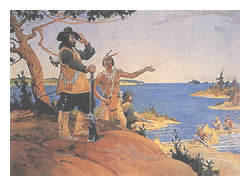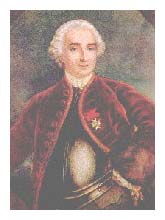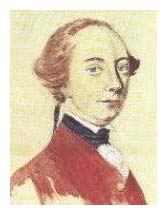 |
| New France |
The Founding of New France
Throughout the rest of the 16th century the European fishing
fleets continued to make almost annual visits to the eastern
shores of Canada. Chiefly as a sideline of the fishing industry,
there continued an unorganized traffic in furs. At home in Europe
new methods of processing furs were developed and beaver hats
in particular grew very fashionable. Thus new encouragement
was given to the infant fur trade in Canada.
In 1598 Troilus de Mesgouez, marquis de la Roche, set out for
Canada armed with a new kind of authority--a royal monopoly
which gave him the exclusive right to trade in furs. La Roche
established a small colony on Sable Island, an isolated Atlantic
sandbar southeast of Nova Scotia. The settlement, which proved
a dismal failure, was the first of a series of efforts by France
to persuade various leaders to set up colonies in Canada in
return for an official monopoly of the fur trade. Pierre Chauvin
in 1600 established a trading post at Tadoussac, on the St.
Lawrence River. This post survived for about three years. In
1604 the fur monopoly was granted to Pierre du Guast, sieur
de Monts. He led his first colonizing expedition to an island
located near the mouth of the St. Croix River. This in time
was to mark the international boundary between the province
of New Brunswick and the state of Maine.

Champlain overlooking Lake
Huron |
Among his lieutenants was a geographer named Samuel de Champlain,
who promptly carried out a major exploration of the northeastern
coastline of what is now the United States (see Champlain).
In the spring the St. Croix settlement was moved to a new site
across the Bay of Fundy, on the shore of the Annapolis Basin,
an inlet in western Nova Scotia. Here at Port Royal in 1605
a settlement Champlain described as the Habitation was established.
It was France's most successful colony to date. The land came
to be known as Acadia.
Samuel De Champlain -
The Father of New France
The cancellation of De Monts's fur monopoly in 1607 brought
the Port Royal settlement to a temporary end. Champlain persuaded
his leader to allow him to take colonists and "go and settle
on the great River St. Lawrence, with which I was familiar through
a voyage that I had made there." In 1608 he founded France's
first permanent Canadian colony. It was at Quebec, at the foot
of a great rocky cape on the north shore, which formed a natural
fortress barring the way upstream to the interior.

French settlement of the
early 17th century (reconstruction) |
The early years of the Quebec colony were hard, and the population
grew slowly. Champlain administered its affairs and took personal
charge of an organized exploration of the unknown interior.
Where he did not actually travel himself, he sent other men.
One was Etienne Brule, the first white man to cross Pennsylvania
and later the first to see Lake Superior. Champlain himself
discovered Lake Champlain (1609); and in 1615 he journeyed by
canoe up the Ottawa, through Lake Nipissing, and down Georgian
Bay to the heart of the Huron country, near Lake Simcoe. During
these journeys Champlain aided the Hurons in battles against
the Iroquois Confederacy. As a result, the Iroquois became mortal
enemies of the French.
In 1629 Champlain suffered the humiliation of having to surrender
his almost starving garrison to an English fleet that appeared
before Quebec. He was taken to England as a prisoner. Peace,
however, had been declared between England and France before
the surrender, and New France was accordingly restored to the
French. Champlain returned from Europe to spend his few remaining
years. He became governor of New France in 1633.
For the Glory of God
New France continued to grow slowly. The fur trade served both
to keep alive an interest in the territory and at the same time
to discourage the development of agriculture, the surest foundation
of a colony in the New World. Settlers founded Trois-Rivieres,
farther up the St. Lawrence, in 1634.
The most distant outpost for many years was Montreal, founded
by Paul de Chomedy, sieur de Maisonneuve, on May 18, 1642. First
known as Ville-Marie, this settlement, one day to become Canada's
largest city, was begun as a mission post. One of the most famous
of the leaders who accompanied Maisonneuve was Jeanne Mance,
founder of the Hotel-Dieu, the first hospital at Ville-Marie.
The establishing of Montreal was part of a large Canadian missionary
movement which was based in France. The work and self-sacrifice
of the Christian missionaries in the young colony and in the
wilds that lay beyond it is one of the most stirring chapters
in the history of New France. During the 40 years following
the founding of Quebec, a dozen mission posts were built in
the Huron country south of Georgian Bay.
The Hurons lived under constant threat of attack by the other
Iroquois tribes dwelling south and east of Lake Ontario. Suddenly,
in 1648, the Iroquois launched their final invasion of Huronia.
Several brave Jesuit priests died as martyrs, and within a year
both the Hurons and the missionaries had been either wiped out
or driven elsewhere. The Iroquois menace continued as one of
the great obtacles to the expansion of settlement.
The history of New France contains many accounts of heroism
on the part of soldiers, settlers, and missionaries during this
long guerrilla warfare on the outskirts of the colony. In 1660
Adam Dollard des Ormeaux led a small band of men in a stand
to the death against an Iroquois war party which was on its
way to destroy the settlement at Montreal. When they had counted
the losses they suffered at the hands of so few Frenchmen, the
Indians abandoned their plans. As late as 1692, 14-year-old
Marie-Madeleine de Vercheres with only five companions defended
her father's fort for two days against marauding Iroquois until
help arrived.
Seigneurs &Habitants
(Lords and peasants)
The feudal system of landholding, which had long been established
in France, was adopted in the colony. The nobles, in this case
the seigneurs, were granted lands and titles by the king in
return for their oath of loyalty and promise to support him
in time of war. The seigneur in turn granted rights to work
farm plots on his land to his vassals, or habitants. In exchange,
the habitants were required to pay certain feudal dues each
year, to work for the seigneur for a given number of days annually,
and to have their grain ground in the seigneurial mill.
In underpopulated New France the habitants welcomed the fact
that the seigneur was obligated to build a mill. They had no
military duties to perform except their common defense against
the Indians. There was little money and not much use for it;
and so the taxes took the form of payments in chickens, geese,
or other farm products. These obligations were hardly burdensome.
The seigneurs were anxious that their habitants should wish
to stay farmers, and there was as much land as anyone could
till.
Governor, Intendant,
and Bishop
As in France, there was nothing resembling a democratic system
of government in the colony. The senior official was the governor,
appointed by the king. In the exercise of his almost abolute
power he felt more responsible to the king in France than to
the people he governed.
Another post of French officialdom was established in Canada
in 1665 with the appointment of an intendant, whose chief duties
concerned finance and the administration of justice. However,
there was sufficient overlapping of authority between governor
and intendant to breed more jealousy than cooperation between
the two offices. Jean Talon, who had come to New France as intendant
in 1665, brought about a rapid expansion of the colony. He encouraged
agriculture, business, crafts, and exploration and stimulated
immigration. Under his direction, a census of New France was
taken in 1666, which showed a population of 3,215. By that time
the English controlled ten colonies on the Atlantic coast to
the south, and they had greatly exceeded New France in population
and self-sufficiency.
In 1672 Count Louis de Frontenac arrived in the colony as governor.
He built a fort at Cataraqui, near present-day Kingston, and
brought the Iroquois into an enforced peace. He directed a series
of major exploratory voyages to the interior. Among the greatest
explorations were those made by Louis Jolliet, Father Jacques
Marquette, and Rene Cavelier, Sieur de La Salle. By 1682, however,
the troubles between Frontenac and the intendant, Jacques Duchesneau,
had become so serious that the king recalled both governor and
intendant. Frontenac was sent out as governor again in 1689,
just after a new war had broken out between France and England.
He carried the fighting right into the English colonies, dispatching
expeditions overland against the settlements to the south in
the dead of winter. When Sir William Phips led a British fleet
upstream to Quebec in 1690, the fiery old French governor haughtily
refused the demand for surrender, saying to the emissary of
the English commander, "I will answer your general by the mouths
of my cannon!"
In 1674, with the elevation of the vicar apostolic, Francois
Xavier de Laval-Montmorency, to the rank of bishop, a new and
powerful office was created at the head of the clergy in New
France. Laval organized the parish system in the colony, gave
encouragement to the missionaries, and founded Quebec Seminary
for the training of young men for the priesthood. He resigned
his office in 1684 but spent the last 20 years of his life in
the seminary he had established in Quebec.
French and English Rivalry
While the English colonies were growing rapidly along the Atlantic
seaboard, French fur traders and explorers were extending long
but thinly supported strands of ownership deep into the heart
of North America. La Salle's exploration of the Mississippi
to its mouth in 1682 gave France a claim to a vast area bordering
the American Colonies from the Great Lakes and the Ohio River
valley southward to the Gulf of Mexico.
It could be only a matter of time before the rivalries between
France and England elsewhere in the world would be sharply reflected
in a final struggle for the ownership of the North American
continent. England's concern over France's threatened control
of much more than half the continent began as early as Henry
Hudson's last voyage, in the time of Champlain , and the probings
for the Northwest Passage by such explorers as Sir Martin Frobisher,
John Davis, and William Baffin.
England came to realize that the easiest riches of the New World
were to be found in furs rather than in gold. Thus it was quick
to follow up its claim to the back-door route to the fur country
by founding the Hudson's Bay Company in 1670, on the suggestion
of Pierre Esprit de Radisson and Medart Chouart, sieur de Groseilliers
For many years England's domination of Hudson Bay was threatened
by the French. In 1686 Pierre Troyes led an amazing overland
expedition from Montreal to the shores of the bay, where his
followers succeeded in capturing a number of the company forts
by surprise. In his party was one of the most daring and brilliant
leaders in the history of New France, Pierre le Moyne, sieur
d'Iberville.
Iberville commanded a series of naval raids into the bay during
the next few years and almost succeeded in driving the English
from this part of the continent altogether. A fresh struggle
between France and England, known as Queen Anne's War, broke
out in 1702 and led to the capture of Port Royal by the English
in 1710. The Treaty of Utrecht, which reestablished peace in
1713, required France to surrender the Hudson Bay Territory,
Newfoundland, and Acadia. France was permitted to keep Cape
Breton Island as well as her inland colonies.
As an immediate result of this setback, France founded the powerful
Fortress of Louisbourg on Cape Breton Island. It was to serve
as a year-round military and naval base for France's remaining
North American empire and also to protect the entrance to the
St. Lawrence River. Louisbourg was developed into the most heavily
fortified bastion in North America during the next 25 years.
In 1745 an army of New Englanders led by Sir William Pepperell
mounted an expedition of 90 vessels and 4,000 men against Louisbourg.
The fortress had become a hornet's nest of raiders who preyed
on the merchant ships of the American Colonies. Within three
months the New Englanders succeeded in forcing Louisbourg to
surrender. The fortress was returned to France, however, by
the Treaty of Aix-la Chapelle signed in 1748. To counterbalance
the renewed threat from Louisbourg, England set up an Atlantic
bastion of its own. In 1749 a fleet bearing more than 2,500
new settlers from the British Isles began the construction of
the city of Halifax.

Montcalm |
The Final Struggle for
the Continent
Peace between the two rival powers did not last long. Fresh
fighting broke out in the New World even before the beginning
of the Seven Years' War in Europe (1756-63). As early as 1754
an expedition was sent against French-held Fort Duquesne, in
the Ohio River valley where the city of Pittsburgh now stands.
This and a second expedition the next year were both unsuccessful.
In 1755 a tragic episode occurred in Acadia. The Acadian French
who refused to take the oath of allegiance to the English king
were herded aboard transports and shipped to the English colonies
to the south. American histories refer to the fighting that
began in 1754 as the French and Indian War. Canadian and European
histories usually treat the final contest for the continent
as beginning in 1756, with the opening of the Seven Years' War.
With the two motherlands in conflict, the English objective
in North America was to overrun New France and particularly
to seize Quebec, the nerve center of the colony. Under the skillful
generalship of Louis Joseph de Montcalm-Gozon, marquis de St-Veran,
the routes to Quebec down the St. Lawrence from Lake Ontario
and north down the Richelieu were successfully closed. The first
was stopped at Oswego, and the second at Ticonderoga. The French
won brilliant victories at both these points. The third route
lay up the St. Lawrence, past the French stronghold of Louisbourg.

Wolfe |
In 1758 a powerful British force landed on Cape Breton Island.
In the fighting that followed, Louisbourg fell for the second
and last time in its history. The waterway to Quebec was open
at last. In 1759 a fleet of 140 ships, carrying 9,000 troops
commanded by Gen. James Wolfe, sailed up the St. Lawrence and
laid siege to the capital of New France. All summer long Wolfe
tried in vain to find a weakness in the natural defenses of
Quebec, which Montcalm was using so skillfully. Late in the
season, he decided on a secret but brilliant night landing that
led to victory the next morning in the celebrated battle of
the Plains of Abraham. Both Wolfe and Montcalm were mortally
wounded in the fighting. Montreal, cut off from all hope of
reinforcements and supplies from France, fell easily before
the advancing British forces the following season. When the
Treaty of Paris at last brought the Seven Years' War to a close
in 1763, the British flag waved over almost the whole of eastern
North America.
|
|